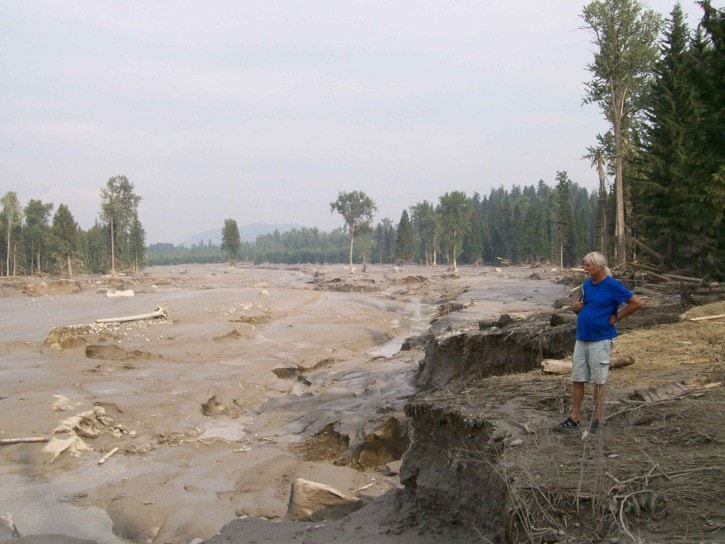A report issued last week by the Mount Polley Independent Expert Engineering Investigation and Review Panel concluded that the tailings pond was built on an unstable foundation.
Characterized as a “ticking time bomb,” the foundation of the pond, which consisted of layers of unstable glacial silt, was subject to more pressure throughout the years as a series of steep additions added to its burden.
Experts said that the initial studies failed to understand how complex the glacial material was when the initial construction of the base of the dam took place. As the dam was raised to hold more water and tailings weakened base layer and it eventually collapsed.
“Basically the weight of the dam was too much for the weak materials in the foundation to bear,” said U.S. consulting engineer Steven Vick, one of three experts called in to examine the failure that caused the dam to breach and fail in August 2014.
There are currently 98 permitted tailings storage facilities in the province with 123 dams at 60 metal and coal mines in B.C.
Last week the panel made seven recommendations and three actions that were announced by Minister of Energy and Mines Bill Bennett.
All operating mines with tailings storage facility dams will now have to provide a letter to the ministry by June 30, 2015 to confirm whether the foundation materials similar to those at Mount Polley exist below any of their dams.
There is also a new requirement that all operating mines with tailings storage facilities establish independent tailings pond review boards.
Finally, there will be a code review to determine how to best implement the panel’s remaining recommendations, including the adoption of best available practices and technologies.
First Nations leaders in the area, who have responded favourably to the Panel’s recommendations, have also assembled their own panel of experts to investigate the disaster.
“We were very pleased with the recommendations, very grateful for the recommendations,” said Bev Sellars from the Soda Creek Band. “The recommendations are what First Nations and environmentalists have been saying so long, that the mining industry and resource industry as well, needs to change.”
Sage Birchwater, a reporter in the Cariboo region, reported in a recent article that the water flowing into Quesnel Lake is still murky six months after the disaster.
In mid-January the Xat’sull/Soda Creek First Nation, Williams Lake First Nations, and the Northern Secwepemc Tribal Council (NStQ) hosted a meeting and introduced the panel of experts hired by the Tribal Council.
“We are looking into the cause of the breach and struggling to understand the ongoing impact on the environment,” said NStQ mining co-oordinator Jacinda Mack. “With our own experts, we’re working as equals, not just reviewing government and Mount Polley reports.”
Many of these experts explained that the long-term effects of the toxins on fish and the environment may not be felt for many years.
Brian Olding, NStQ’s environmental planner, credited Mount Polley for responding quickly to the disaster, but said that is still huge uncertainty on how long-lasting the effects of the breach will be.
Ernest Kroeker, fisheries manager for NStQ, said the spill is affecting two kinds of fish: migratory salmon and resident Quesnel Lake Rainbow trout. Kroeker said the biggest concern for the Sockeye isn’t the spawning grounds; it’s the rearing grounds.
“Quesnel Lake is the nursery where juvenile sockeye feed for a whole year,” he said. “If toxins are mobile and bio-available, it’s going to be a big problem.”
This breach has focused attention on other mines throughout the province, and that there could be similar disasters just waiting to happen.
Bennett said the ministry will be reaching out to all mining operators in the province to see if their mines might have been built on glacial till and if so, whether they were built with that instability in mind.
“If there is any question at all of similar circumstances to what existed at Mount Polley on your mine site, you need to tell us so that we can do further inspections,” Bennett said.
The report also indicated that the failure was triggered by construction of the downstream rockfill zone at a steep slope. The Panel concluded that had the downstream slope been flattened failure would have been avoided. The slope was in the process of being flattened to meet its ultimate design criteria at the time of the accident.
The NStQ had been hard at work developing a mining policy based on the best mining practices around the world when the breach occurred. Since the 400-page document was released on the NStQ website it has received a thousand downloads from all over the world.
“The more people who use this policy the better it will be for everybody,” said Chief Sellars.
With files from the Green Gazette, GlobalBC and CBC News
